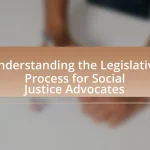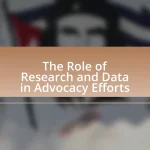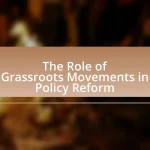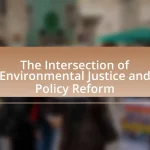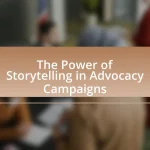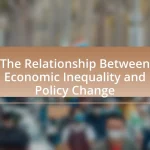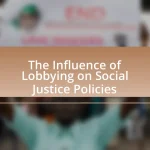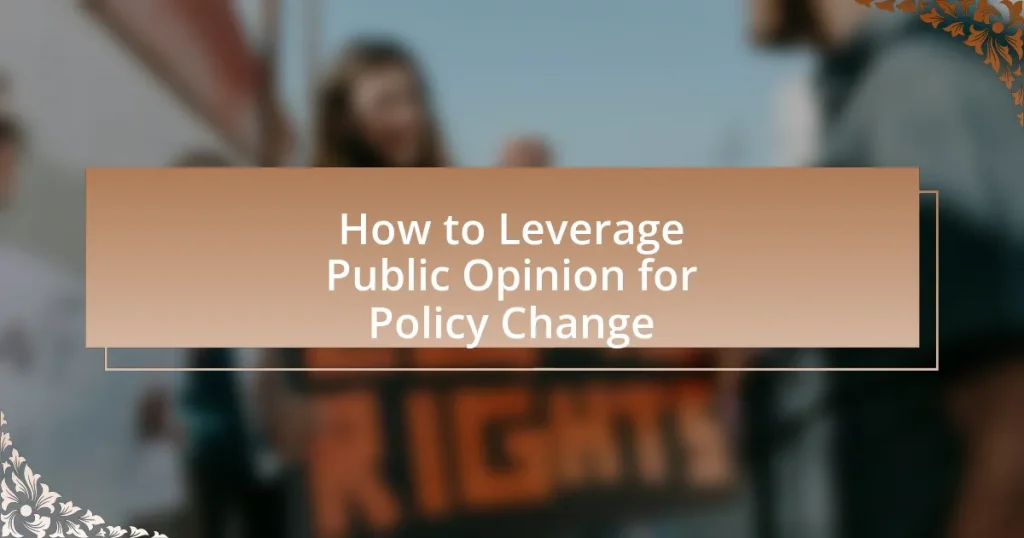The article focuses on the critical role of public opinion in driving policy change, emphasizing how it influences decision-makers and shapes legislative agendas. It explores mechanisms connecting public sentiment to policy decisions, including electoral pressure, public discourse, and interest group advocacy. The article also discusses the importance of understanding public opinion for effective advocacy, the consequences of ignoring it, and strategies for leveraging it through social media and grassroots movements. Additionally, it addresses challenges such as misinformation and media bias, while providing best practices for organizations to measure and utilize public sentiment effectively in their campaigns for policy change.
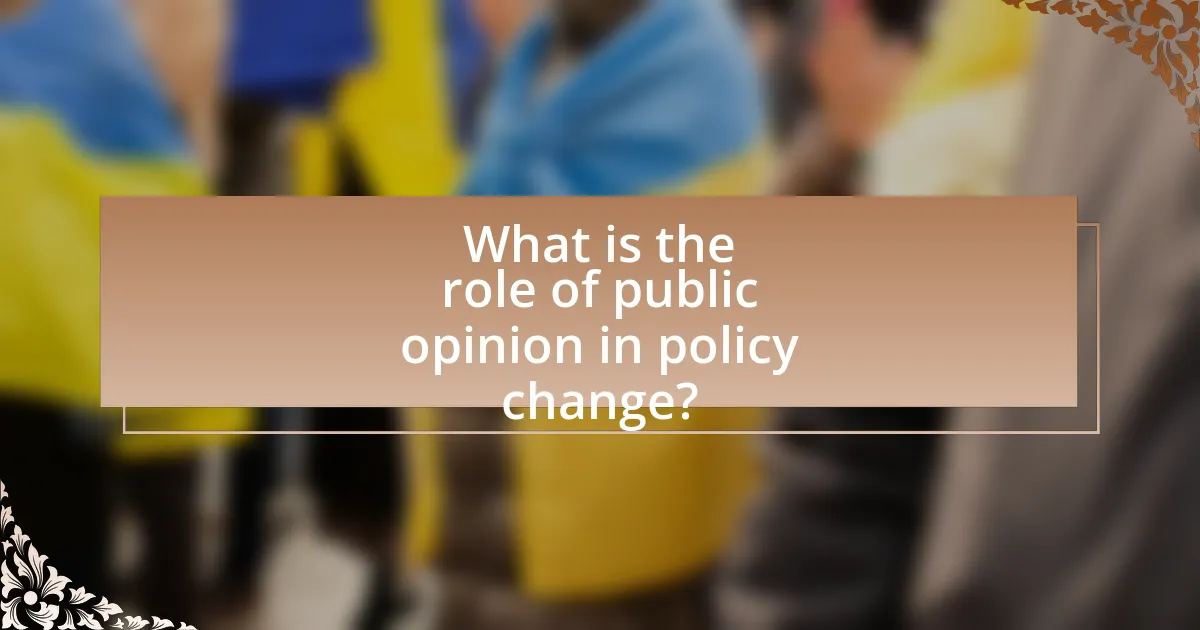
What is the role of public opinion in policy change?
Public opinion plays a crucial role in policy change by influencing decision-makers and shaping legislative agendas. When a significant portion of the public expresses support or opposition to specific issues, policymakers often respond to these sentiments to align with constituents’ preferences and maintain electoral support. For instance, research conducted by the Pew Research Center indicates that public opinion can lead to shifts in policy, as seen in the legalization of same-sex marriage in the United States, where changing public attitudes prompted legislative changes across various states. This demonstrates that public opinion not only reflects societal values but also serves as a catalyst for policy reform.
How does public opinion influence policymakers?
Public opinion significantly influences policymakers by shaping their decisions and legislative priorities. Policymakers often rely on public sentiment to gauge the popularity of issues, which can affect their electoral prospects. For instance, a study by the Pew Research Center found that 70% of Americans believe that public opinion should play a significant role in government decision-making. This pressure can lead to policy changes, as elected officials seek to align their actions with the views of their constituents to maintain support and ensure re-election. Additionally, public opinion can manifest through protests, social media campaigns, and voting behavior, further compelling policymakers to respond to the prevailing attitudes and demands of the populace.
What mechanisms connect public opinion to policy decisions?
Public opinion influences policy decisions through mechanisms such as electoral pressure, public discourse, and interest group advocacy. Electoral pressure occurs when policymakers respond to the preferences of constituents to secure votes, as evidenced by studies showing that elected officials often align their positions with public sentiment to enhance re-election chances. Public discourse, facilitated by media coverage and social platforms, shapes the political agenda by highlighting specific issues, compelling policymakers to address them. Additionally, interest groups mobilize public opinion to advocate for specific policies, leveraging surveys and polls to demonstrate widespread support, which can sway legislative action. These interconnected mechanisms illustrate how public opinion serves as a critical driver of policy formulation and change.
How do public opinion polls shape legislative agendas?
Public opinion polls significantly shape legislative agendas by providing lawmakers with insights into the preferences and priorities of their constituents. These polls inform elected officials about the issues that matter most to the public, allowing them to align their legislative efforts with voter sentiment. For instance, a 2021 Gallup poll indicated that 70% of Americans prioritized healthcare reform, prompting legislators to focus on related policies. By responding to public opinion, lawmakers can enhance their chances of re-election and ensure that their policies reflect the needs of the electorate.
Why is understanding public opinion crucial for advocacy?
Understanding public opinion is crucial for advocacy because it shapes the effectiveness of campaigns and influences policymakers. Advocacy efforts that align with the views and concerns of the public are more likely to gain support and achieve desired outcomes. For instance, research by the Pew Research Center indicates that public support can significantly impact legislative decisions, as elected officials often respond to the preferences of their constituents. Therefore, comprehending public sentiment allows advocates to tailor their messages, strategies, and initiatives to resonate with the audience, ultimately enhancing the likelihood of successful policy change.
What are the consequences of ignoring public sentiment?
Ignoring public sentiment can lead to significant political and social consequences, including loss of trust, decreased legitimacy, and potential unrest. When policymakers disregard the views and feelings of the public, they risk alienating constituents, which can result in lower voter turnout and diminished support for future initiatives. Historical examples, such as the backlash against the Vietnam War, illustrate how ignoring public opinion can lead to widespread protests and a shift in policy direction. Additionally, research indicates that organizations and governments that fail to engage with public sentiment often face reputational damage, as seen in various corporate scandals where consumer backlash led to financial losses.
How can advocacy groups effectively gauge public opinion?
Advocacy groups can effectively gauge public opinion by utilizing a combination of surveys, focus groups, and social media analytics. Surveys provide quantitative data on public attitudes, while focus groups offer qualitative insights into the reasoning behind those attitudes. For instance, a 2021 Pew Research Center study found that 67% of Americans support stricter gun laws, demonstrating how surveys can reveal significant trends in public sentiment. Additionally, social media analytics allow advocacy groups to monitor real-time discussions and sentiments, enabling them to adapt their strategies based on current public discourse. By integrating these methods, advocacy groups can obtain a comprehensive understanding of public opinion, which is crucial for influencing policy change.
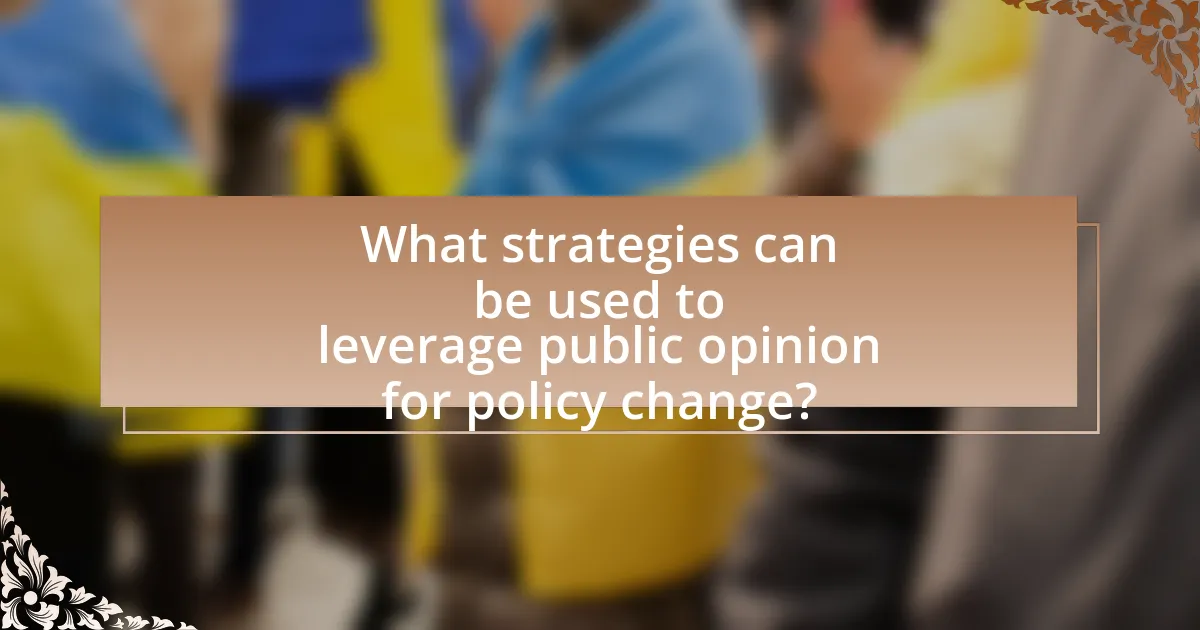
What strategies can be used to leverage public opinion for policy change?
To leverage public opinion for policy change, strategies include utilizing social media campaigns, conducting public surveys, and engaging in grassroots organizing. Social media campaigns can amplify messages and mobilize supporters quickly, as evidenced by the success of movements like #MeToo, which significantly influenced public discourse and policy regarding sexual harassment. Conducting public surveys helps gauge public sentiment and identify key issues, allowing policymakers to align their proposals with constituents’ priorities. Grassroots organizing fosters community involvement and builds coalitions, demonstrated by the success of local initiatives that have led to significant policy changes, such as the push for climate action in various cities. These strategies collectively create a powerful platform for influencing policymakers and driving change.
How can social media be utilized to influence public opinion?
Social media can be utilized to influence public opinion by facilitating the rapid dissemination of information and enabling direct engagement between individuals and organizations. Platforms like Twitter and Facebook allow users to share content widely, which can shape perceptions and mobilize support for specific issues. For instance, studies show that social media campaigns can significantly impact public attitudes; a 2018 study published in the journal “Political Communication” found that exposure to political content on social media increased political engagement and shifted opinions among users. Additionally, social media allows for targeted messaging, where organizations can tailor their communications to specific demographics, enhancing the effectiveness of their influence on public opinion.
What are the best practices for engaging audiences on social platforms?
The best practices for engaging audiences on social platforms include creating authentic content, utilizing interactive features, and analyzing audience insights. Authentic content fosters trust and relatability, which are essential for building a loyal following; studies show that 86% of consumers prefer authenticity in brand messaging. Utilizing interactive features such as polls, quizzes, and live Q&A sessions encourages audience participation and enhances engagement. Additionally, analyzing audience insights allows for tailored content that resonates with specific demographics, leading to a 70% increase in engagement rates when content aligns with audience preferences.
How can viral campaigns impact policy discussions?
Viral campaigns can significantly influence policy discussions by amplifying public awareness and mobilizing grassroots support for specific issues. These campaigns often utilize social media platforms to rapidly disseminate information, creating a sense of urgency and collective action among the public. For instance, the Ice Bucket Challenge in 2014 raised awareness and funding for ALS research, leading to increased government support for related policies. Research indicates that viral campaigns can shift public opinion, which in turn pressures policymakers to respond to constituents’ demands, as seen in movements like #MeToo and Black Lives Matter, which have reshaped discussions around sexual harassment and racial justice legislation.
What role do grassroots movements play in shaping public opinion?
Grassroots movements play a crucial role in shaping public opinion by mobilizing community members around specific issues, thereby amplifying voices that may otherwise be marginalized. These movements often utilize social media and local organizing to raise awareness, educate the public, and foster a sense of collective identity among supporters. For instance, the Black Lives Matter movement has significantly influenced public discourse on racial justice and police reform, leading to widespread protests and policy discussions across the United States. Research indicates that grassroots campaigns can shift public attitudes, as seen in the 2018 March for Our Lives, which galvanized youth activism around gun control and resulted in increased support for related legislation.
How can local initiatives drive national policy changes?
Local initiatives can drive national policy changes by demonstrating successful models that influence broader legislative agendas. When grassroots movements effectively address community issues, they can garner media attention and public support, which pressures national policymakers to adopt similar strategies. For example, the local implementation of renewable energy programs has led to national discussions on climate policy, as seen in California’s aggressive climate initiatives prompting federal interest in sustainable practices. This illustrates how localized efforts can serve as proof of concept, showcasing the viability of policies that can be scaled nationally.
What are successful examples of grassroots campaigns influencing policy?
Successful examples of grassroots campaigns influencing policy include the Civil Rights Movement and the Fight for $15 campaign. The Civil Rights Movement, particularly in the 1960s, mobilized citizens to advocate for racial equality, leading to significant legislative changes such as the Civil Rights Act of 1964 and the Voting Rights Act of 1965. The Fight for $15 campaign, initiated in 2012, successfully pushed for higher minimum wages across various states and cities, resulting in policy changes in places like New York and California, where minimum wage laws were raised to $15 per hour. These campaigns demonstrate the power of organized grassroots efforts in shaping public policy through sustained advocacy and public engagement.
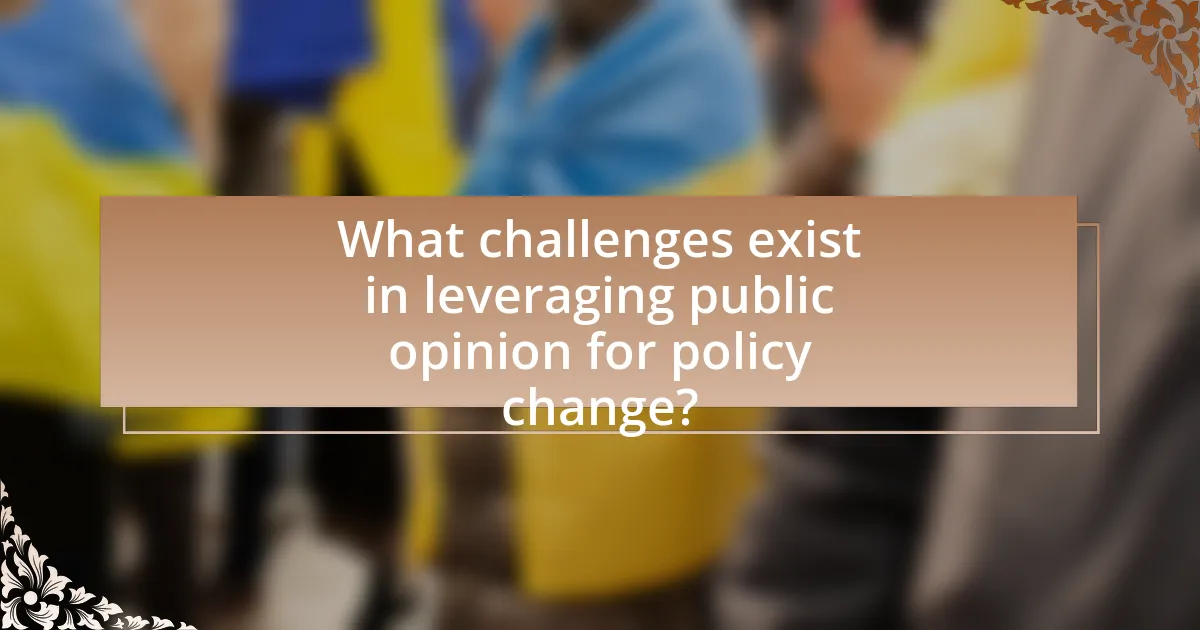
What challenges exist in leveraging public opinion for policy change?
Challenges in leveraging public opinion for policy change include the difficulty in accurately measuring public sentiment, the influence of misinformation, and the potential for public opinion to be polarized. Accurately gauging public opinion often relies on surveys, which can be biased or unrepresentative, leading to flawed policy decisions. Misinformation can distort public perception, complicating the ability of policymakers to respond effectively to genuine public concerns. Additionally, polarized opinions can create a divide that makes consensus-building challenging, hindering the implementation of effective policies. For instance, a 2020 Pew Research Center study found that partisan divides on key issues have widened, complicating efforts to achieve bipartisan support for policy initiatives.
How can misinformation affect public perception and policy outcomes?
Misinformation can significantly distort public perception and influence policy outcomes by shaping beliefs and attitudes based on false or misleading information. For instance, studies have shown that misinformation can lead to increased polarization on issues such as climate change and vaccination, where individuals may reject scientific consensus due to exposure to false narratives. A 2019 study published in the journal “Science” found that misinformation can spread faster and more widely than factual information, leading to misinformed public opinions that policymakers may feel compelled to address. Consequently, when a substantial portion of the public holds misconceptions, policymakers may enact laws or regulations that reflect these distorted views rather than evidence-based solutions, ultimately hindering effective governance and public health initiatives.
What strategies can combat misinformation in public discourse?
To combat misinformation in public discourse, implementing fact-checking initiatives is essential. Fact-checking organizations, such as PolitiFact and FactCheck.org, systematically verify claims made in public statements and media, providing accurate information to counter false narratives. Research shows that exposure to fact-checking can significantly reduce the belief in misinformation, as demonstrated in a study published in the journal “Communication Research,” which found that individuals who encountered fact-checks were less likely to endorse false claims. Additionally, promoting media literacy programs equips the public with skills to critically evaluate information sources, further diminishing the impact of misinformation.
How does media bias influence public opinion on policy issues?
Media bias significantly influences public opinion on policy issues by shaping perceptions and framing narratives. Biased reporting can lead to selective emphasis on certain facts while downplaying others, which alters how the public understands and reacts to policy matters. For instance, studies have shown that media outlets with a particular ideological slant can affect audience attitudes; research by the Pew Research Center indicates that individuals exposed to partisan news are more likely to adopt similar views on policy issues. This influence is further amplified by the echo chamber effect, where individuals consume media that reinforces their existing beliefs, leading to polarized opinions on critical policies.
What are the limitations of relying on public opinion for policy change?
Relying on public opinion for policy change has significant limitations, including the potential for misinformation and the volatility of public sentiment. Misinformation can skew public perception, leading to misguided policy decisions; for instance, studies show that social media can amplify false narratives, which may influence public opinion and, consequently, policymakers. Additionally, public opinion is often transient, as seen in polling data where support for issues can fluctuate rapidly, making it challenging for policymakers to base long-term strategies on shifting sentiments. This inconsistency can result in policies that lack stability and coherence, ultimately undermining effective governance.
How can fluctuating public sentiment complicate policy formulation?
Fluctuating public sentiment complicates policy formulation by creating uncertainty and inconsistency in the priorities and preferences of the electorate. When public opinion shifts rapidly, policymakers may struggle to align their proposals with the current mood, leading to potential backlash or loss of support. For instance, a study by the Pew Research Center found that public opinion on issues like climate change can change significantly within short time frames, making it challenging for legislators to craft stable, long-term policies. This volatility can result in policies that are reactive rather than proactive, ultimately undermining effective governance and long-term planning.
What ethical considerations arise when manipulating public opinion?
Manipulating public opinion raises significant ethical considerations, primarily concerning deception, autonomy, and the potential for harm. Deception occurs when information is intentionally distorted or omitted, undermining the public’s ability to make informed decisions. Autonomy is compromised when individuals are influenced without their consent or awareness, leading to questions about free will and personal agency. Additionally, the potential for harm arises when manipulated opinions lead to societal division, misinformation, or the promotion of harmful policies. Historical examples, such as propaganda used during wartime, illustrate the consequences of unethical manipulation, where public sentiment was swayed to justify actions that resulted in widespread suffering.
What are the best practices for effectively leveraging public opinion?
To effectively leverage public opinion, organizations should engage in active listening, utilize data analytics, and foster transparent communication. Active listening involves gathering feedback through surveys and social media to understand public sentiment. Data analytics allows for the identification of trends and key issues that resonate with the audience, enabling targeted messaging. Transparent communication builds trust and encourages public participation, which is essential for influencing policy change. For instance, a study by the Pew Research Center found that 70% of Americans believe that public opinion should influence government decisions, highlighting the importance of aligning strategies with public sentiment.
How can organizations create impactful campaigns based on public sentiment?
Organizations can create impactful campaigns based on public sentiment by utilizing data analytics to gauge public opinion and tailoring their messaging accordingly. By employing tools such as social media monitoring, surveys, and sentiment analysis, organizations can identify key issues that resonate with their target audience. For instance, a study by Pew Research Center found that 69% of adults in the U.S. use social media, making it a vital platform for understanding public sentiment. Additionally, aligning campaign goals with the values and concerns of the public can enhance engagement and support. This approach not only fosters a connection with the audience but also increases the likelihood of achieving desired policy changes.
What tools and resources are available for measuring public opinion?
Surveys and polls are primary tools for measuring public opinion, providing quantitative data on people’s attitudes and beliefs. Organizations like Gallup and Pew Research Center conduct regular surveys that track public sentiment on various issues, offering insights into trends over time. Additionally, social media analytics tools, such as Brandwatch and Hootsuite, analyze public sentiment through user-generated content, allowing for real-time feedback on public opinion. Academic research, such as studies published in journals like Public Opinion Quarterly, also contributes to understanding public sentiment through rigorous methodologies. These resources collectively enable policymakers to gauge public opinion effectively and make informed decisions.
